





























Embarking on the open water is an exhilarating experience, flled with the promise of adventure and relaxation. Whether you’re a seasoned sailor or a weekend cruiser, protecting your vessel with proper insurance is not just a choice—it’s a necessity. Explore the reasons why every boat owner should prioritize boat insurance for a worry-free voyage.
The open water can be unpredictable, with unexpected storms, collisions, or other potential accidents. Boat insurance can give you fnancial protection if there is damage to your vessel, providing coverage for repairs or replacement.
Accidents on the water can result in damage to other boats, docks, or even injuries to passengers. Boat insurance offers liability coverage, which can pay for damages or injuries you’re liable for while boating, up to specifed limits, and lawsuit costs if you’re sued. This includes damage you cause to another watercraft or if someone on or near your boat is injured and you’re found to be legally responsible.
Unfortunately, boat theft and vandalism are realities that boat owners face. Boat insurance has comprehensive and collision coverage that can protect you against events outside of your control, including theft and vandalism.
Accidents on the water may lead to injuries for you or your passengers. Boat insurance offers a range of optional medical payments coverage limits, helping to cover medical expenses if you are in an accident or someone is hurt on your boat, regardless of fault.
If you fnanced the purchase of your boat, most lenders require insurance coverage to protect their investment. Having boat insurance not only fulflls these requirements but also gives you peace of mind knowing that your fnancial interests are safeguarded.


Some water municipalities and marinas may require proof of insurance for docking or accessing certain areas. Boat insurance allows you the fexibility to explore different destinations without worrying about entry restrictions.
Emergency towing and assistance
Progressive boat insurance can include optional Sign & Glide® On-Water Towing coverage. If your boat is disabled or breaks down on the water, Sign & Glide® pays for on-water towing, jump starts, soft un-groundings, and fuel delivery.
Wreckage removal
If your boat sinks, Progressive boat insurance will cover the cost of removing your boat from the water (if removal is legally required).
Investing in boat insurance is not just about protecting a valuable asset; it’s about safeguarding the memories, experiences, and joy that come with your on-water adventures. Don’t let unforeseen circumstances disrupt your journey—navigate with confdence, knowing that Progressive boat insurance has you covered. Ensure a smooth and worry-free voyage, because when it comes to your boat, peace of mind is the ultimate luxury.
Scan to get a quote in as little as 4 minutes
learn more.





















May is one of my favorite months for o!shore shing, as the shing seasons coincide with good weather. Being spared from the beginning of hurricane season until next month, right now is the most reliable time to get nice weather days to make the trek to deeper waters.
Mahi season has begun to be more consistent, making the trips o!shore more exciting and worthwhile. When making the long drive to the humps for black n tuna, or the sword sh ledges, it’s always a plus to know that you have opportunities to catch mahi on the way there and back. Staying alert for weedlines, diving birds and oating debris makes the trip seem like less of a chore, and keeps that sherman’s optimism alive for more of the venture, knowing you’re still on the hunt nearly the whole way back to the dock.
With the prevalence of mahi, tuna, queen snapper and sword sh in our deepwater shery, May 1st marks the opening of grouper season here in e Florida Keys, providing additional catching opportunities for both nearshore and o!shore adventures. We also welcome the opening of tile sh this month.
For those with an electric reel setup in their arsenal, this is a great month to get out there and scout for new deep-dropping locations. With snowy grouper and yellowedge grouper found peppered throughout the area, test dropping on new found spots can be a fun addition to mahi shing. As you run aimlessly o!shore looking for
signs of dolphin sh, you may notice you run over a ledge or depth variation. Anything that looks shy a%er about 500’ could be your next honeyhole.
By Capt. Quinlyn Haddon

If this is a new area especially, use a variety of baits on your 5-hook deepdrop rig to ensure your best chances of surveying the location. Squid is always a good choice o!shore, with many species unable to resist its potent aroma, but chunks of sh should be included to entice a grouper bite. With bait sizes matching hook sizes, its a good idea to make your own rigs with di!erent sized hooks if you’re unsure of the species that might be available at a new place. A x larger hooks near the bottom of the rig for grouper baits, and smaller hooks near the top with squid for tile sh.
If o!shore isn’t your thing, there are plenty of grouper on the reef and wrecks nearshore this time of year as well. However, a%er releasing these sandwich providers since their closing January 1st, every local sherman in town will be hitting the wrecks hard for the recaptures now that season is open. Before they face all this pressure from being targeted nearshore, particularly on publicly known wrecks, it’s a good time to put some skin in the nearshore grouper game.
A%er a short closure for the month of April, amberjack has also opened again this month.

ese sh are easy to nd, and add some nice backbreaking action to the grouper hunt.
Whatever your avor of shing is, e Florida Keys has you covered this month. With the anticipated opening of grouper season at the beginning of May, and schools closing for summer break nearing the end, it’s a good idea to get booked for a charter before you arrive on your Keys vacation.
Give us a call at Sweet E’nuf Charters to get tight.
Capt. Quinlyn Haddon guides with Sweet E’Nuf Charters out of Marathon, e Florida Keys. (504) 920-6342. www.captainquinlyn.com; IG: @captainquinlyn
Whether you’re chasing trophy fish or charting your next offshore course, your time on the water deserves the best in navigation and marine technology. Defender brings you UNBEATABLE PRICES and EXPERT SUPPORT on Lowrance and Simrad electronics—trusted by professionals and weekend warriors alike.


and navigation that keeps you locked on target.



No ofense to those nifty little knives that the Swiss pack a kitchen into, but sometimes it takes a big blade to get the job done. Tat was the case three years ago when I found myself in the jungles of Argentina.
I’d heard a tale about lost Inca gold and was on the hunt for clues. Among other things, the Inca were known for their extensive road system that ran at least 25,000 miles along South America’s eastern side. But the clue I was looking for was down a long-abandoned road overtaken by jungle.

Join the over 492,000 sharp people who own Stauer knives
That’s when my Pathfinder Blade came to the rescue. Constructed of high-quality 420 surgical stainless steel and with a total length of 16 inches, this full-tang knife made quick work of the jungle brush. And with its rugged handle of genuine, natural white bone that’s been hand-carved and torched with an iconic design, I didn’t lose my grip. Rounded off by brass spacers, handguards, a brown pakkawood handle, and hand engravings on the blade’s spine, this baby is all you could ever handle in jungle brush.

Upon reaching a stone wall hidden by the jungle, I snapped my knife back into its tooled genuine leather sheath and read the markings the Incas had left long ago. It was time to travel north for the next part of my adventure.
To make your next adventure even better, we’re including a pair of Stauer Flyboy Optics® Sunglasses— a $99 value—FREE with your purchase of the Pathfinder Blade. Lightweight, and ready to go wherever you do, these sunglasses are the perfect companion to help you stay sharp on the trail.

Flyboy Optics® Sunglasses a $99value with your purchase of the Pathfinder Blade




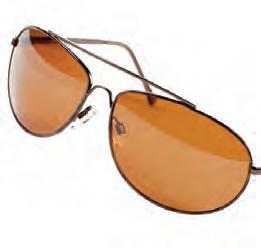




What Stauer Clients Are Saying About Our Knives
“This knife is beautiful!” — J., La Crescent, MN Knife Specifcations:
• 16" total length.
• High-quality 420 surgical stainless steel blade
• Full-tang construction. Handle of genuine, natural white bone that’s been hand-carved and torched

• Brass spacers and handguards, brown pakkawood handle, and hand engravings on the blade spine
• Leather sheath included Pathfinder Blade

$349 $99* + S&P Save $250
California residents please call 1-800-333-2045 regarding Proposition 65 regulations before purchasing this product.
*Special price only for customers using the offer code.






By Riley Love


nly in the dreams of shermen does this occur. A wondrous game sh pursued across ve countries not only awaits but the biggest, baddest, best of them lay for you in a single place.
e Salminus Brasiliensis is certainly not related to salmon, but is of the order Characiformes which includes many species— notably vampire-fanged payara and modern cinema star piranha in South America and tiger sh in Africa. Redundantly named the golden dorado (dorado means “golden” in Spanish), it’s immensely powerful, acrobatic—and magni cently beautiful.
e Rio Uruguay (indigenous Guarani interpretation “bird river”), with the northern border of Argentina and southern of Uruguay, sports a massive hydroelectric dam, the “El Salto Grande.” Stunned eels and bait sh ow through the locks in highly oxygenated water to the waiting predators. Permits are required by the dual operators on the Argentinian and Uruguay sides of the river to sh within 1,000 meters from the dam. Fishing is rigidly structured into slots of three hours quartered per weekdays per group of two or three anglers in two boats in this “Zona.” e Argentinians lost their permits recently and our two cra% had the entire area to ourselves. Downstream, twenty other boats oated outside the zone a kilometer away, prohibited from approaching nearer. My inner voice asked, “How o%en does this happen to me?”

ere are a lot of places to sh for golden dorado in Argentina, Bolivia, Paraguay, Uruguay and Brazil. One would note that the world record is a bit cloudy; there is a 70 lb. specimen claimed in 1970 but without a veri cation or a photo. To re ect on the quality of this shery, the current IGFA record is just over 55 lbs. and taken at La Zona. Our group landed numerous sh into the mid-40 lb. range, within 80% of the documented record. In contrast, the renowned, luxurious golden dorado destination, Pira Lodge, gets about one sh over 30 lbs. annually. shermen do well here. Locals target carp-like boga both for live bait and food. Using large topwater poppers, Rapala style diving minnows and handmade jigs, we hit rocky structure and fastmoving torrents. e dorado were exceedingly sensitive to water levels and ow being released from the dam. When it happened and their buttons were pushed, it was double digit trophies in each time slot. Multiple hookups were common.

Fishing teaches us lessons about life. Whether love, war or business, if you want success you need multiple opportunities. Even with shoulder- wrenching, reel-screaming strikes and Hank Aaron grade roundhouse hooksets, over half of what seemed like solid hookups would suddenly vanish from the transaction. It’s very much like trying to land large toothy- jawed payara. e modus operandi of these golden hulks revealed that even extra strong hooks were straightened, sometimes pulled from the lures; 65 lb. braid and wire leaders were broken. But some just “Houdinied” away, still waiting for you to come, instead of only dreaming.
Justi Campa of Fly Fishing Patagonia assisted with our planning. Reach them by emailing jcampa@ y shingpatagonia.com or visit www. y shingpatagonia.com.

Riley Love is a physician and author with homes in Kentucky and Key Largo, Fla. He has penned dozens of articles on international sport shing and a host of screenplays. He is a member of the International Game Fish Association, e Bill sh Foundation and the Outdoor Writers Association of America. Contact him at 270-816-4423, rjhclove@gmail.com or visit his website: rileylove.com.




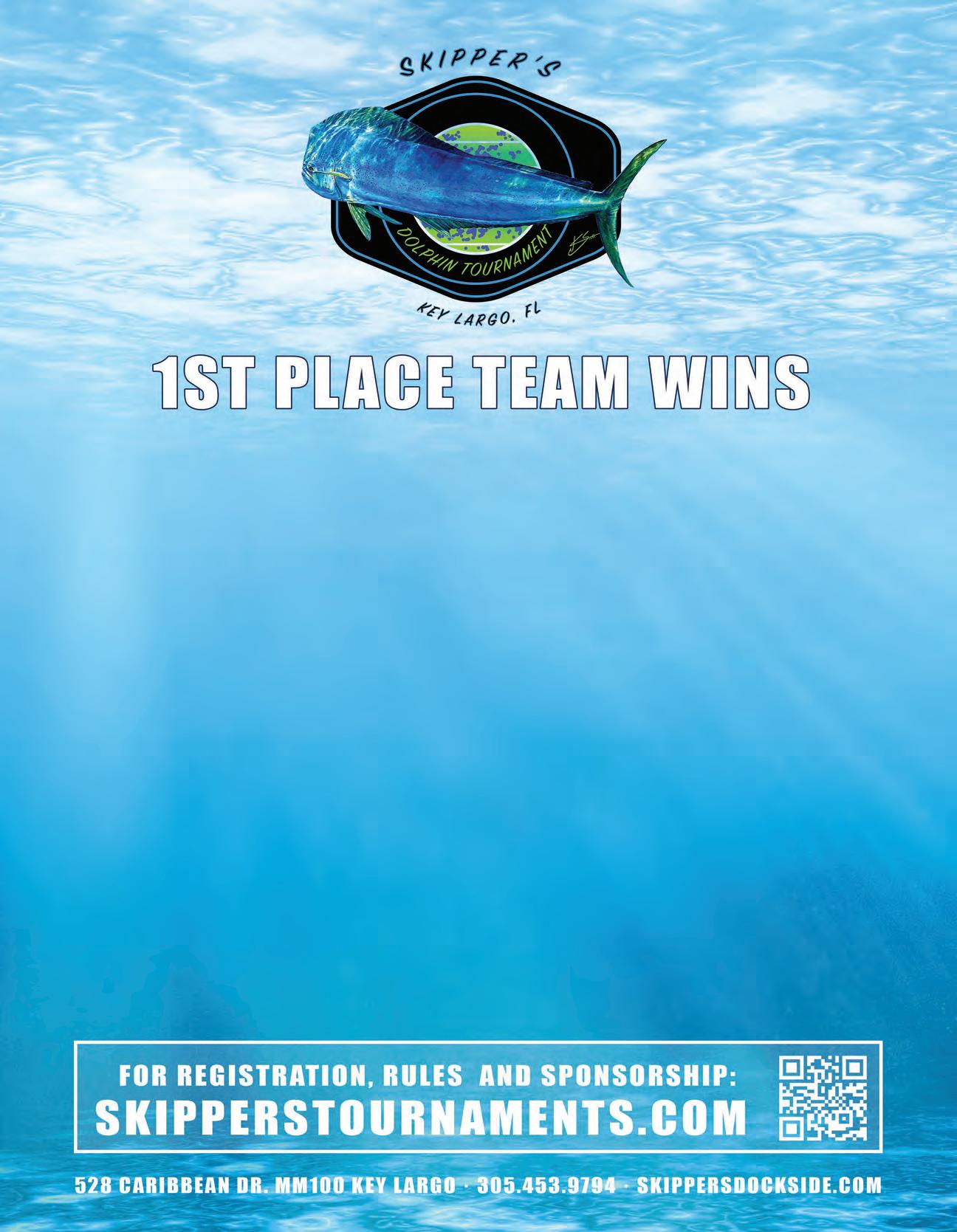

Performance Bulletin Available

60 YEARS OF REPOWER EXPERIENCE!
Mastry Engine Center has received the Suzuki Marine Super Service Award and has been ranked #1 in Suzuki Marine US Sales!
Repower packages designed to best ft your needs and not stretch your budget. Financing available.
Suzuki RePowers include a fve-year Factory Direct Warranty.

Stationed strategically around the southeast, all Suzuki RePower Centers have achieved the highest level of Suzuki Service Certifcations to meet and exceed your repower needs.
Many of our Suzuki RePower Centers feature Water Accessible Drop Travel Lifts.






It’s no fsh tale when you run with a John Deere. You can get everything done faster and easier, so you get more time on the water. Plus, our special offers make them the catch of the day.






By Capt. Michael
If you’re a dedicated trout angler like me, you’re probably eyeing the opportunity to land a personal best speckled trout before the spring spawn.
While most Texas anglers focus on big trout from mid-December to early April, May o!ers a prime window for trophy sh, especially with the full moon on May 12 this year. e warmer weather also makes shing more enjoyable, creating a perfect environment for those seeking action-packed outings.
May sees many anglers shi$ing focus and putting away their waders. However, big speckled trout are still holding onto their eggs, making this an excellent opportunity to catch one before they spawn. e pleasant temperatures in May allow us to use more aggressive lures and speed up our presentations, a welcome change from the slow, careful approach required in
winter. For those who enjoy a faster pace, May is the time to go.
One of my favorite techniques for targeting trophy trout in May is using topwater lures. e explosive strikes on the surface are thrilling, and the warmer waters make sh more eager to strike. But topwater isn’t the only option—slow-sinking and suspending lures also perform well. As a paddletail enthusiast, I recommend experimenting with 3”, 4”, and 5” sizes and adapting to the sh preference. At this time of year, trout are aggressive, so adding rattling sounds to your lures can make a di!erence.
In terms of location, I prefer shing grass %ats in water that is knee- to waist-deep. Flats with small creek drains or depressions are incredibly productive, as these features tend to concentrate sh. Shallow grass areas are ideal, and potholes can increase your chances of nding a big trout. ese areas o!er an excellent opportunity to catch a he$y sh before the season transitions.
However, shing in May can be challenging due to the abundance of small bait sh in the water, like tiny glass minnows. Trout are o$en gorging on these minuscule meals, making it di&cult to grab their attention with larger lures. e key is downsizing your lures to match the size of the bait sh. I’ve found that using the smallest lure you can cast e!ectively is the best approach when you see an abundance of small bait sh. Both hard and so$ lures are e!ective, and colors like white and silver tend to mimic the forage closely.
When shing around bait balls, I recommend positioning your lure on the edge or beneath the school. is strategy attracts sh to a single target, rather than competing with a large mass of bait sh. Slow-sinking lures are ideal, as they give the appearance of wounded prey, which trout nd irresistible.
Tandem rigs are another excellent option for spring shing. By rigging two smaller lures, you can cast farther while still maintaining the proper lure size. A combination of small silver spoons and white bucktails works well when shing around glass minnows. A small %oater diver with a spoon trailer also adds an extra level of action.
In the spring, downsizing your lure presentation can make a signi cant di!erence in your success, potentially leading to the big trout you’ve been waiting for.
Capt. Michael Okruhlik is the inventor of Knockin Tail Lures®, and the owner of www.MyCoastOutdoors.com.



Late spring through summer marks the prime season for tripletail !shing in the Florida Keys. Known for their unique appearance and strong !ght, these !sh are a favorite for anglers looking to challenge their skills. Tripletail are opportunistic feeders, o en lurking around oating structures like buoys, weed lines, or even debris in the water, so learning how to spot them and presenting the right bait are key to a successful catch.
By A. deGruchy

When targeting tripletail, it’s important to have the right gear for the job. A 7’ to 7’6” medium rod with a fast action will provide the strength and responsiveness needed to manage their powerful runs. Pair this with a 3000–4000 size reel. We rely on the PENN Battalion paired with the 3500 PENN Authority as our personal set up. For leaders, a 20 lb. uorocarbon leader is good, along with a 3/0 circle hook. We trust the Mustad UltraPoint hooks for their sharpness and strength. For bait, shrimp or small white bait are both top choices.
Finding tripletail requires enough daylight and minimal clouds for visibility. $ey prefer oating structures such as buoys or patches of oating seaweed, so keep an eye out for these areas while cruising the waters. A key factor in casting is to land as light as possible near the !sh, allowing the bait

naturally with the current. Tripletail are o en slow movers, so be swi and avoid sudden movements that might scare them o%. A light and steady retrieve will give your bait the best chance of getting tight.
Tripletail !shing in the Florida Keys can be incredibly rewarding, especially when you hook into one of these feisty !ghters. $ey also make excellent table fare if you wanted to catch and cook, getting the full sea-totable experience.
Book your adventure now at www.beansport!shing.com as our trips !ll up fast!
Follow deGruchy’s adventures at @bean_sport shing on Instagram and YouTube.















ShoreStation hydraulic boat lifts are a reliable choice for coastal residents and boating enthusiasts alike. Their strong construction, made with corrosion-resistant materials, allows them to withstand harsh environmental conditions, including sun, storms, and saltwater damage. ShoreStation provides a steadfast solution for protecting waterfront investments, o ering peace of mind to owners in the Sunshine State.







Equipped with exceptional weather resistant fabric and breathable SunTex 80 woven mesh ends for maximum protection and durability,

Made from the highest quality materials, our innovative hydraulic boat lift is one of the fastest and safest lifts on the market today. When you have a hydraulic lift, there’s no need to worry about wind and waves getting in your way. This lift will give you con dence to safely land and secure your boat in less-than-ideal conditions.
Never miss another moment on the water. Power your lift with clean, free solar power. Our speedy 20 watt charger features solar regulator drainage protection, saving your battery from permanent damage caused by overcharging.



Florida’s bass !shing scene just got a serious jolt of excitement, thanks to an unforgettable day on the water for angler Alie Abrell. Back in February, in the heart of Marion County, Alie landed what many dream of but few achieve—a jaw-dropping 10-pound largemouth bass that has quickly become the talk of the !shing community.
Fishing with the renowned Trophy Bass Expeditions and under the seasoned eye of Captain Sean Rush, Alie hooked into the massive bass during what turned out to be a picture-perfect outing. As the !ght unfolded, it became clear this was no ordinary catch. When the !sh !nally surfaced, it was con!rmed: Alie had o&cially entered the elite double-digit club—a milestone that every serious bass angler aspires to reach.
$e catch is more than just a personal triumph for Alie—it’s a sign that Florida’s peak bass season is o% to an electrifying start. Known for its trophy-sized bass and scenic waters, Marion County is already delivering on its reputation, and this monster catch sets a high bar for the rest of the season.
“Moments like this are what we live for,” said Captain Rush. “To see an angler connect with a !sh of that caliber—it’s unforgettable.”
As word of the catch spreads, anglers across the Sunshine State are gearing up for what promises to be a record-setting year. With warming waters and peak season just ramping up, it’s a prime time to get out there and chase giants.
Huge kudos to Alie for reeling in the bass of a lifetime—and a big shoutout to Captain Rush for once again guiding an angler to glory. If this epic moment is any indication of what’s to come, Florida’s bass !shing faithful have every reason to be !red up.
So, gear up and cast out—because the big ones are biting!
For more info visit https://license.gooutdoors orida.com/Angler/Home




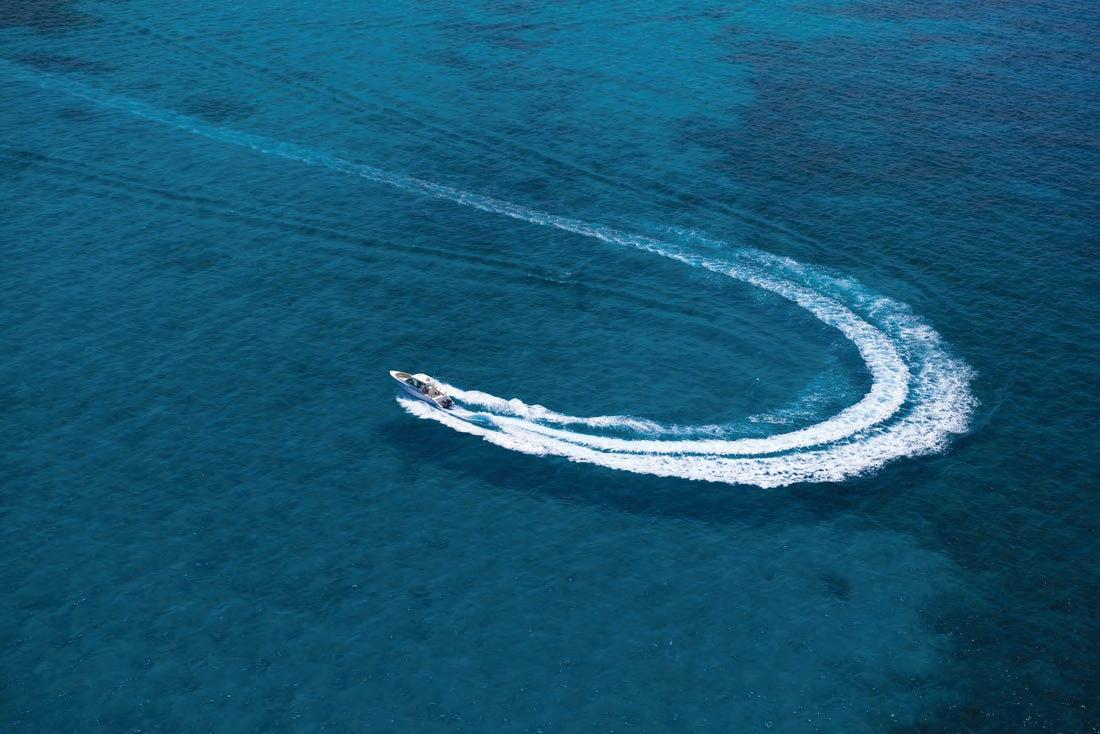






YOU’RE INVITED TO THE GRAND OPENING OF SKY MARINE ORLANDO!
GET READY, CENTRAL FLORIDA — SOMETHING EXCITING IS CRUISING YOUR WAY! SKY MARINE ORLANDO IS THRILLED TO ANNOUNCE THE GRAND OPENING OF THE AREA’S NEWESTAND FASTEST-GROWING BOAT AND CART DEALERSHIP! JOIN US JUNE 5TH & 6TH FOR TWO DAYS OF FUN,CELEBRATION, AND COMMUNITY VIBES.
SATURDAY, JUNE 6TH WILL BE PACKED WITH: LIVE MUSIC, DELICIOUS FOOD & REFRESHING DRINKS, GAMES & ACTIVITIES, EXCITING GIVEAWAYS, FAMILY-FRIENDLY ENTERTAINMENT

LOCATION: SKY MARINE ORLANDO WWW.SKYMARINEORLANDO.COM • (407) 688-3030 4165 N US HWY 17-92 SANFORD FL,32773
WHETHER YOU’RE A BOATING ENTHUSIAST, GOLF CART LOVER, OR JUST LOOKING FOR AGREAT TIME — YOU WON’TWANT TO MISS THIS! SEE YOU THERE!




EDITOR

DARLENE TAYLOR DISTRIBUTION
JERRY TAYLOR


Redfish, snook and sea trout can all be found in the Haulover Canal. For the big redfish, I typically use ½ or whole live blue crabs with a 5/0 circle hook and 40 lb. fluorocarbon leader with 30 lb. braid. Depending on the speed of the current, use a ½to 2-ounce sinker with a swivel and when freelining throw up current of the school of redfish. For best results use your electronics with side imaging. You can also anchor in Haulover and wait with a ½ or whole crab. Pitching large live croakers works very well too; try around the fenders and trees for big redfish. For snook and seatrout use live shrimp, finger mullet and croakers on a 3/0 J hook with 30 lb. fluorocarbon leader tied to 10-30 lb. braid. You will still lose a few snook on the 30 lb. leader, but when you step up to 40 lb. you will not get as many bites. Try skipping a white paddle tail under the mangroves in Haulover Canal; a bit of current helps to have better results.
May is also a great time of the year for catching redfish, sea trout and black drum on the flats. The grass is getting higher, so pitch into the sand holes using paddle tails, live shrimp or gold spoons with 20 lb. leader tied to 6-10 lb. braid. For black drum, if I can see them, I will throw live shrimp or a piece of shrimp on a jig head and let it sit. May also brings more consistent weather and less wind.
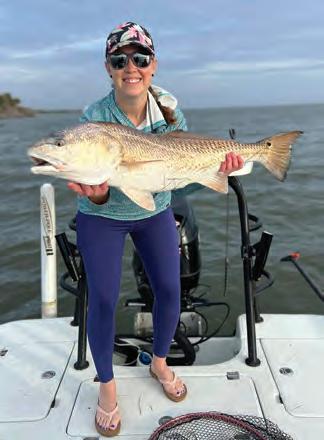
Capt. Glyn Austin
Capt. Lukas Brickweg
Capt. Chris Cameron
Capt. Barry Englehardt
Capt. Scott Goodwin
Charlie McCullough
Capt. Troy Perez
Capt. Jim Ross
Capt. Michael Savedow
Capt. Jamie Thrappas
In the ocean and nearshore, you may have a chance at a tripletail on the buoys, and free swimmers if we have strong southeast winds. Tarpon will also show up on the beach in late May and June. Usually, once the large schools of bait like pogies show up so do the tarpon. Sharks will be thick this time of the year around the schools of bait fish with large jacks and big redfish mixed in.
Troy’s Tip of the Month: when fishing Haulover in May, the winds may be calm, so make sure you wear long pants, long sleeve shirt, or have lots of bug spray because no-see-ums and mosquitoes will be fierce in the morning.
CAPT. TROY PEREZ
Troy Perez Fishing facebook.com/captaintroyfl capt.troyperez@gmail.com (321) 607-2033








May is a fantastic month to fish in the Port Canaveral area. Although I will be running my fishing charters in the Islamorada section of the Florida Keys this month chasing permit, bonefish and tarpon, anglers fishing the waters around Canaveral will find plenty of great fish to target.
The insane snook bite we have experienced throughout March and April should continue through the end of this month. Snook are prone to strike live baits much more readily than artificial lures along the beaches, jetties and docks. Live shrimp, croaker, spot, mullet, pinfish and menhaden will usually get their attention. Most of these fish are slightly over the slot limit, but if you like catching big snook, now is the time to go.
Tarpon schools will begin to show up along the beaches following menhaden (a.k.a. pogie) pods that are migrating up the coast. Schools of big jack crevalle, multiple types of sharks, and even a few smaller species like pompano and whiting will be possible for anglers fishing on the beach or just outside of the surf break. Expect more of the same with even more tarpon showing up in June, but that’s a fishing forecast for next month’s edition of this magazine.
May is time for you to get out here and catch your next memory!










Is it just me or is anyone else wondering where all the cobia went? Who knows? We had a few good days of beautiful weather...with an empty ocean. We even saw a few hundred rays with nothing on them. Odd. But the good news is that this is also the timeframe we start seeing them free swimming out on the reefs. While you’re out there slow trolling for kings, keep an eye out the back of the boat for that cobia trailing you. If you’re bottom fishing, keep an eye on what follows your fish up to the boat. The sandbar sharks seem to be holding…
Good numbers of mahi have been caught the last few weeks and should only increase this month. Start in the 90- to 120-foot range as many seem to think you have to go to 300 feet right off the get go. Unless someone is out there telling you to “C’mon,” start shallow. Start looking for color changes and temp breaks. Also look for weed lines and currents, as that is a good place to start. I like to use smaller islander lures with small ballyhoo or strip baits. On bright sunny days go with the yellows, pinks and bright blues; on darker days go with black, red, and purple colors.



Kingfish will continue to do well this month, too. Best bait is going to be the bunker. Now that the water is warming up, live bait is much more consistent. Some days you may have to ride far south to get it and some days its right there in the Port, but at least it’s around. Beach fishing is really starting to heat up as well. We’ve already seen some nice buoy line kings and tarpon. If the bait’s around, chances are there will be larger fish feeding. I like to start with 60# mono ’til I start getting cut off, then I switch to #4 wire. Shark fishing has been on fire! I know many say they don’t want to deal
with sharks or you can’t eat them, but they are completely wrong. On light tackle they are so much fun, and blacktips are great to eat. Ever wonder why Grills always runs out of the shark kabobs? And I assure you, there’s no shark shortage. Just take what you will eat! No waste. We need there to be plenty of sharks and every other species for our future kids.




After an unusually cold winter where Banana River temperatures plummeted to 54 degrees at one point, spring has finally pulled our water temps back to near 80 degrees on the sunny days. From our homebase at Marker 24 Marina, we welcome the return of finger mullet, one of our favorite baits, as well as the occasional pilchard and threadfin herring. Huge schools of bay anchovies have the pelicans diving hard and I’m sure a wide variety of species are feasting.
Low water levels are probably affecting our fishing the most because many of our favorite haunts are only inches deep and overhanging branches no longer touch the water. We anxiously await the rise of water levels, but it’s anybody’s guess when that will be.

We’re still catching redfish and snook and hearing reports of black drum in the area. Juvenile tarpon still hole up in canals as well as some trout clinging to the deeper water.
The best news is the sprouting of true seagrass in spots, and the shallow depths are protecting it from manatees. Hopefully we will enjoy clear water and wakening fishing opportunities this month.
CAPT. SCOTT GOODWIN
Marker 24 Fishing Charters www.marker24marina.com (321) 536-7597
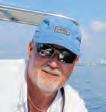




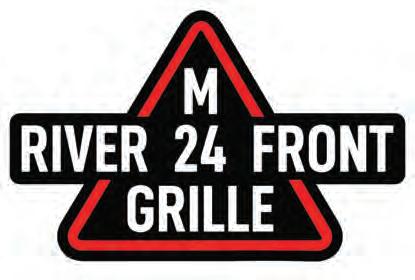





Capt. Scott Goodwin here with Marker 24 Marina on Merritt Island. I’m very excited to be part of the Marker 24 family as captain of the fishing fleet. I’ve spent the last 30+ years in the realm of professional fishing as a mate and captain on both charter and private sportfish boats, and I enjoy the variety of chores around our quaint but bustling marina and restaurant.
The more time I spend on the property, the more amazed I am at its unique, natural setting for a first-class marina.
The addition of Marker 24 Riverfront Grille has transformed the atmosphere into one of tropical relaxation. The fresh fish is the specialty, but a full menu and bar keep everyone coming back. By boat and car, locals and visitors are flocking to spend time listening to music under the palms while enjoying great food and drinks in our open-air patio venue. The M24 Riverfront is open Wednesday to Sunday from 11:30 to 8:30.
Dolphin and manatee feed and shelter in the marina almost daily, and the amount of nature on site is incredible. During the past six years the property has been undergoing multiple updates. Often, we have visitors who come to check out the new docks, buildings, boatyard, and slips, and they are all blown away at the transformation that has taken place. The marina’s pilings, docks, power, and water systems are all new. Many of the wet slips also feature boat lifts, offering the benefit of eliminating bottom growth on your hull and running gear while being ready to splash and go!
The break wall that surrounded the marina in the old days has gotten a makeover, and the living, mangrove-covered coquina break wall is growing nicely. This will not only provide shelter for slips on the “river-side” of



the marina but will create a rich habitat for fish and wildlife as well. This sheltered cove will be the perfect combination of access to the Banana and Indian River Lagoon and Port Canaveral from slips and boat lifts sheltered from the elements.
We also have a fully operational boatyard and travel lift offering services to our customers, guests, and transients.
On the “river-side,” we have a service department ready to take on a wide variety of boat repairs and maintenance, as well as being a Mercury Marine Dealer.
The marina store is well-appointed with apparel, gifts, snacks, drinks, frozen bait, live shrimp, and all the necessary tackle and fishing gear to make the most of your time on the water. Our helpful and friendly staff is standing by to pump either ethanol-free gas or diesel, to lift the only privately-owned drawbridge in Florida, or to assist with any other items our guests might need.
Our goal is to make using your boat easier, safer, and more fun!
Come check out the new Marker 24 Marina at 1357 South Banana River Dr., Merritt Island, Fla. It really is a one-stop shop for boating and fun!

Joey Kuba, 12, hooked this red off a dock in Indialantic on the Indian River between the causeways with cut bait on a large rod nicknamed”The Sledge.‟
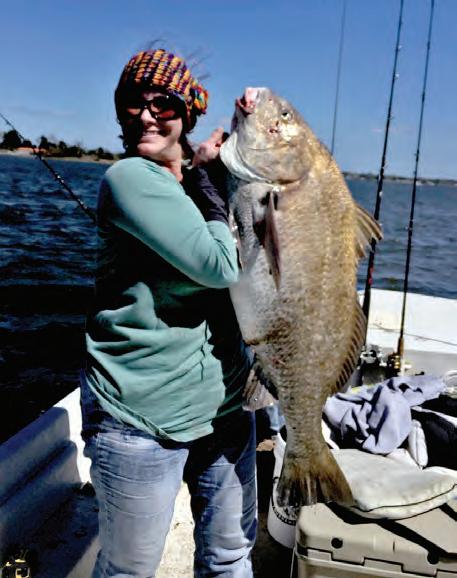
Katina Zaros shows off one of four hefty black drum she caught fishing with blue crab on the St. Johns River.

Haylee Green poses with the first snook she ever caught. Hooked in Sebastian, it was 33 inches.



12-year-old Jackson is from Cocoa Beach but he spent spring break in the Everglades and caught this beautiful peacock bass.

Perry Cubeta landed this nice 36-inch Crevalle jack in the IRL in Melbourne using a 4.5 inch Yozuri lure, light tackle with 17 lb. test. Took about 12-15 min to reel him in...



Austin Desoto on one of his sickest snook fights:


”Hooked this fish and immediately was taken through multiple pilings. I tossed my friend my back pack and started swimming through the pilings as quick as I could. After a couple minutes of weaving I had her in open water. Taking my time as I was using tackle on the lighter side, I finally landed her. Keeping her in the water majority of the time, gave her a nice revive and she kicked off strong.‟
Dave Cook nabbed this black drum, weighing 45 pounds and measuring 41 inches, off a dock on the IRL.

Using a Shimano Stradic 5000 and a Spanish sardine, Trevor Moulds hooked this 10-pound, 26-inch red grouper off Port Canaveral.

Amy Lombardo got her first keeper tripletail. Caught off Port Canaveral, it meaasured 21.25 inches and weighed 6.72 pounds.




The winds have been brutal this spring and we are looking for May to bring us some relief of the winds. We could also use some more rain! Light winds and some rain will bring the bait nearshore and inshore and get the fish fired up. In between the winds the bite has been decent, but the constant wind and pressure changes have made us really have to work to get decent fish so far this year. The snook bite got good in April and the bait started showing up, but the winds have been brutal. Snook season closes at the end of May, so everyone will be focused on getting their fix of keeper snook—which shouldn’t be hard to do. Live bait is best foe the daytime and artificials work well early morning and early evening.
The larger bluefish have been hitor-miss this year, but there have been some schools around which make for some exciting action.
2.0 10:3110:3110:3110:31 0.3 10:5510:5510:5510:55 0.36:368:00
7
6
2.0 11:2011:2011:2011:20 0.2 11:4511:4511:4511:45 0.36:358:00 2.1 12:0412:0412:0412:04 0.16:358:01
2.2 12:3012:3012:3012:30 0.3 12:4512:4512:4512:45 0.06:348:02
2.2 1:111:111:111:11 0.3
2.3 3:013:013:013:01 0.3 3:083:083:083:08 -0.16:318:04
2.2 3:363:363:363:36 0.3 3:443:443:443:44 0.06:318:04
2.2 4:124:124:124:12 0.4 4:204:204:204:20 0.06:308:05
2.1 4:504:504:504:50 0.4 5:005:005:005:00 0.06:308:06 5:325:325:325:32 0.5 5:455:455:455:45 0.16:298:06 1.9 6:216:216:216:21 0.5 6:386:386:386:38 0.26:298:07
1.9 7:177:177:177:17 0.4 7:387:387:387:38 0.26:288:07
1.9 8:188:188:188:18 0.3 8:438:438:438:43 0.26:288:08
2.1 9:209:209:209:20 0.2 9:489:489:489:48 0.26:278:09
2.2 10:1810:1810:1810:18 0.0 10:5010:5010:5010:50 0.26:278:09
2.4 11:1411:1411:1411:14 -0.3 11:4811:4811:4811:48 0.16:278:10
2.5 12:0812:0812:0812:08 -0.56:268:10
24Sat 5:465:465:465:46 2.2 6:366:366:366:36 2.5 12:0812:0812:0812:08 -0.56:268:10
2.6 12:4212:4212:4212:42 0.0 1:011:011:011:01 -0.66:268:11
2.7 1:351:351:351:35 0.0 1:541:541:541:54 -0.76:258:11
2.7 2:272:272:272:27 -0.1 2:462:462:462:46 -0.76:258:12
2.6 3:193:193:193:19 -0.1 3:393:393:393:39 -0.66:258:12
2.5 4:124:124:124:12 0.0 4:334:334:334:33 -0.56:258:13
2.4 5:075:075:075:07 0.1 5:285:285:285:28 -0.36:248:13
2.2 6:036:036:036:03 0.1 6:256:256:256:25 -0.16:248:14

The inshore bite got pretty good in early April and should get better in May as we get more consistent weather and more bait in the lagoon. The lack of rain has made for low water levels and very clear water. As we get more rain, we should start seeing more glass minnows and mullet in addition to plenty of pilchards in the lagoon, and the snook, trout and reds will be feeding well on the bait schools in the mangroves and around the deeper docks in the lagoon.
May is also a good month for big jacks on the beach and they will eat topwater lures better than anything. If you can find bait schools, there are usually big jacks around feeding on them. Also, look around the bait pods for schools of tarpon. Mixed in with the tarpon can be permit this time of the year. Live shrimp, crabs or artificial shrimp can all work on the permit, while the tarpon prefer greenies during the summer.
The creeks from Melbourne to Sebastian should have some bait schools along with good numbers of tarpon, snook and some jacks. Fish the docks and deeper shorelines for the snook. Some guys like to slow troll live finger mullet along the shoreline for the big snook and tarpon back up in the Sebastian River. Artificial and fly anglers should focus on early morning for the tarpon and snook, but the jacks will feed most of the day.
CAPT. GLYN AUSTIN Going Coastal Charters www.goingcoastalcharters.com (321) 863-8085


May ignites an exciting time of year for spring surf fishing anglers. Look for a new cast of characters to be perusing the shore bound waters. Expect to see flounder, pompano, snook, sharks and tarpon. Below we will discuss the best ways to target fish in the surf for the month of May.
What makes the month of May so special? During this time of year the increasing water temperatures lead the way for the summer conditions. While the month of May is typically categorized as a transitional period, you’ll still be able to catch winter species such as pompano, whiting and bluefish. But take note that snook, flounder and tarpon will also be available. Therefore, the best approach will be a diversified variety of equipment and tactics to target the various species.

For example, the use of a spin casting rod is a tool to add to your surf fishing arsenal. Include swim baits, casting plugs and soft plastics to target predatory species in the first and second trough. This can be accomplished while fishing for pompano and whiting with traditional surf fishing setups.
By walking the shores and casting said lures 45 degrees from the shore, you position yourself to catch snook and flounder with higher probability by keeping your lure in the strike zone longer. The predatory species named above will be quick to ambush, reacting in an instant bite and immediate hook set. So be ready and make sure to keep pressure to coax these fish into the shoreline.
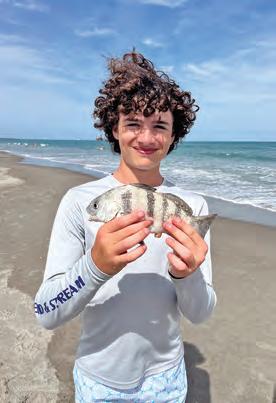

Take note that the majority of large pompano schools will already be way north of the Central East Coast region. But that’s not to say there aren’t resident fish in the area, meaning there’s a great possibility to catch pompano year round on the Space Coast beaches. Use traditional pompano rigs with chartreuse floats and purple beads. Furthermore, the best baits of choice will be live sand fleas, fresh cut shrimp and clams. Get out there and have a ball in this exciting surf fishery.
CAPT. LUKAS BRICKWEG
Cocoa Beach Surf Fishing Charters cocoabeachsurffishingcharters.com (321) 205-4672

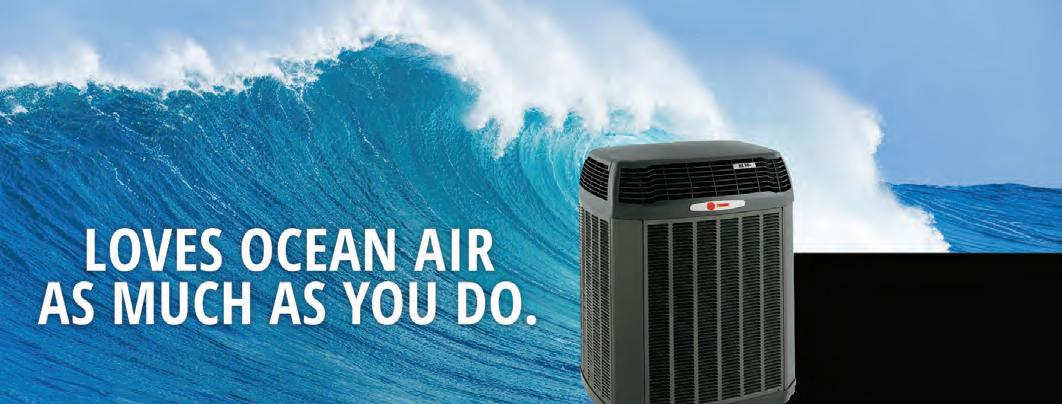





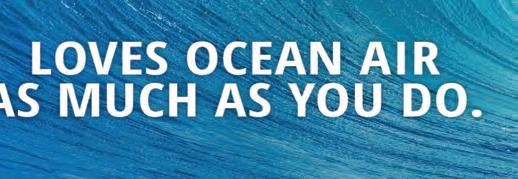









It feels like summer is already here! Early mornings and late evenings are your best bet. Rain is your friend—largemouth bass before, and blue channel catfish after. Panfish spawning should be in full swing, although you won’t smell orange blossoms like years past. Bass will stage near running water near the mouths of Lakes Monroe and Harney. Schooling fish will bite topwater and sub surface slash baits. Bigger fish can be found using Carolina rigs near deeper water away from bedding areas, post spawn. Devils Horse type lures cast mere inches from the shoreline will produce bites. Wait a second when you see the bite, so you don’t pull it out of their mouth, it is one of the hardest things to do. Before the rain when the barometer is lower, the bass bite will be good. After the rain, fish the running water in a deep river bend for big channel cats with peeled fresh shrimp on the bottom.

Jolly Gator Bass Series Tournaments are back; visit them Tuesday evenings at the C.S. Lee boat ramp in Geneva. Anglers check in with Squirt Chaudoin, then launch at 5 p.m. until dusk. Spectators can enter raffle drawings while cheering on their favorite anglers.
Father’s Day is around the corner. For those looking to treat Dad, check out the new rod and reel by Abu Garcia: the Max SX Spinning Combo. This will manage any St. Johns River fishing, even large catfish! If Dad is headed to saltwater, or you think big river catfish need heavy duty tackle, gift him a Penn Battle IV Spinning Combo. Both these rod and reel combos are household names in fishing and will hold up when you hook a big fish.

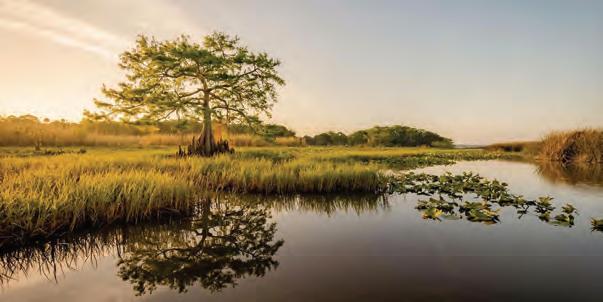

















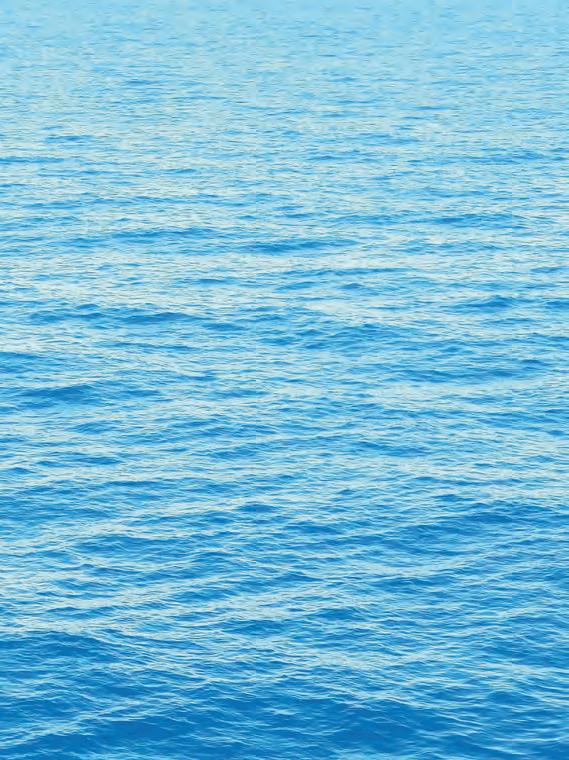











May is the first month with summer fishing patterns, time again to start serious trips before sunrise to take advantage of the first light feeding period. More baitfish—finger mullet, pigfish, croakers, spots, small menhaden and pilchards—will be appearing in the ICW including Edgewater Backcountry and Mosquito Lagoon.
Early morning is topwater lure time. Use smaller and quieter styles when conditions are calm. Try larger and louder lures on choppy water, walkthe-dog types or chugger heads; I like SkitterWalk, Super Spook Jr., Chug Bug, and Zara Puppy. Work top waters tight to oyster bars, shorelines, shallow back bays and flats. Fish the top waters early, then switch to sub surface lures after the sun is up a bit, like twitch baits, MirrOdines, spoons, soft plastic jerk baits, and D.O.A. or Gulp shrimp.
Finger mullet will again be coming into shallow water. Fish them free-lined and tail hooked around the shallow oysters, flats, and shorelines for redfish and trout. On deeper drop offs fish lip-hooked mullet, mud minnows or live shrimp with split shot or 1/4 oz. sinker.
Tarpon and bull redfish return to the Intracoastal Waterway, backcountry and Lagoon waters. Tarpon will show themselves on the surface by rolling and gulping air; as they roll, their dorsal fin and tail break the top of the water.They are notoriously picky, so patience is a must. Live

shrimp, silver dollar blue crab, live finger mullet, plastic swim baits or lures are good to try. Tarpon are a top challenge for fly fishers, with the sight casting chance at a silver king hookup.
Larger redfish will again be along the ICW channel. Watch for surface activity with a lower profile, big boils and surface strikes as they eat drifting blue crabs or baitfish. A free-lined whole or half crab, large live shrimp, pinfish, pigfish, croaker or spot give the best chance of a pick up.
Use heavier tackle for the big reds and tarpon for a shorter fight and healthy release. Hold these bigger fish horizontally for a photo, not hanging from the lip which can damage these valuable breeder-size fish. Remember, only tarpon under 40” are legally allowed to be removed from the water, so a photo with the fish in the water is needed on bigger fish.
Summer is the best time of year for nighttime dock light fishing; the lights attract bait fish and shrimp which, in turn, bring in the trout, jacks, ladyfish, snook and redfish to name a few. A free-lined live shrimp can be the “go-to” bait, or match the hatch of which type of bait you are seeing. Try a small size lure, swim bait, jig, twitch bait, or soft plastic shrimp. Anchor just up tide and a cast out from the light, throw your bait up current from the circle of light on the water and


allow it to “swim” naturally through the target area. Outgoing tide can be best, but a moving tide in either direction is a must for a good bite.


May is usually an excellent month for fishing—and for weather! The low pressure systems stop pushing in from the north and the water really heats up.
I’ll spend a decent amount of time focused on redfish and snook at the inlet on tide switches. Live shrimp, pinfish, mullet and other baitfish will produce your target species.
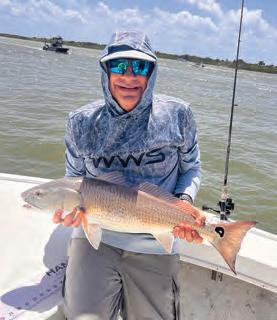

I’ll also start venturing out behind the shrimp boats and beaches chasing tarpon. They usually are the most active with feeding first thing in the morning and again just before sunset. Throwing live baits like mullet or pogies into rolling fish always helps get a bite, but you can also use large 8-12” swim baits to entice a hookup!
Bottom fishing the close reefs outside of Ponce to the north sun glow, and to the south (there’s one off Flagler Ave. in New Smyrna) will also produce fish. Flounder, black drum, redfish, sheepshead, weakfish and more should have those spots on fire as the water temps continue to rise.
Get out there and catch some fish! Summer crowds are right around the corner. Give me a shout if you’d like to book a trip and, as always, if you see us on the water say hello!
CAPT. JAMIE THRAPPAS
Yellow Dawg Fishing www.yellowdawgfishing.com (386) 366-3424


The month of May brings warmer water, bait fish, reds, snook, trout and tarpon.
Snook will be eating as much as they can to get ready for their spawn, which begins in June, and the tarpon will be following schools of bait fish up and down the river, and when they enter the basin the tarpon will venture up river as far as 95.
May is the start of fishing early morning before light. Use live bait attached to a popping cork with a three- or four-foot leader, and open the bail and float it with the current.
The trout and reds will be shallow early morning and my favorite bait is a top water lure. As the day gets warmer use a sub-surface lure or, if you prefer live bait, use shrimp, bait fish or crab on the bottom with a slip sinker.
CAPT. BARRY ENGLEHARDT
Fish With Captain Barry fishwithcaptainbarry.com (386) 871-8500

























May 9th & 10th, 2025
Online Registration: MothersDayDolphinTournament.com
Captain’s Meeting
Liechty Marine
Friday May 9th - 6pm to 7pm
Lines In: Saturday, May 10 - 7:30am
Lines Out: Saturday, May 10 - 3:30pm
Weigh-In
Curly’s Co ee
Saturday, May 10th - 3:30pm to 6pm
Awards Banquet
Marathon Yacht Club
Saturday, May 10th - 7pm
Sunday Honor












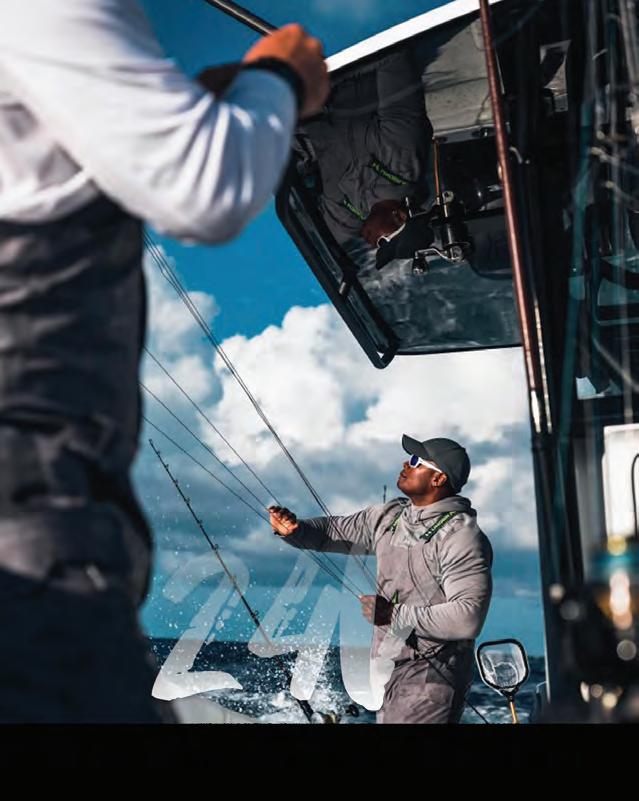







Brevard County, Florida, proudly holds the title of the loggerhead sea turtle capital of our hemisphere. Here, loggerhead nesting occurs so frequently that nests o!en go unmarked on some beaches. From April through the summer months, during nearly any full moon high tide at night, you might witness this natural phenomenon. However, it’s important to keep ashlights o and avoid ash photography to protect these vulnerable creatures.
Daytime nesting is rare for all turtles, making the sight of an endangered leatherback (the world’s largest sea turtle species) even more exceptional.

$is unique event was captured during the evening twilight hours at 6:30 p.m. Monday, April 7, in Satellite Beach, FL. $e Sea Turtle Preservation Society and UCF were on the scene.
Watch the video in this month's Angler Video Mag at vidmag.com and on coastalanglermag.com.
By Ryan Clapper

Headwaters Lake (Fellsmere Reservoir) is a 10,000-acre manmade lake located in Indian River County, adjacent to Stick Marsh/Farm 13. In the early 20th century, this area was drained for agriculture. In 2015, the St. Johns River Water Management District (SJRWMD) purchased the land and began ooding it to aid in ood control and nutrient removal for the Upper St. Johns River Basin. Before ooding, the Florida Fish and Wildlife Conservation Commission (FWC) and SJRWMD collaborated on extensive habitat and %sheries restoration projects to enhance %sh and wildlife habitats and create a premier %shing destination. Between 2011 and 2014, FWC invested $1.35 million in habitat enhancements at Headwaters, including shaping the lakebed with varied elevations such as holes, trenches, drop-o s, humps, and islands.
Following the ooding in 2016, FWC stocked the lake with 1 million Florida bass %ngerlings, 145,000 black crappie, 374,000 redear sun%sh, and 345,000 bluegill to rapidly establish a thriving sport%sh population.


On August 10, 2020, the Headwaters Lake boat ramp opened for the %rst time and the access facility was built in cooperation between the SJRWMD and FWC’s Boating Improvement Fund, which is supported by Sport%sh Restoration Funding. Since the opening of the boat ramp, the FWC has monitored angling e ort, catch, and angler success.
From 2020-2024, Fellsmere has averaged about 160,000+ angling hours annually and a bass catch rate of 1.40 bass per hour (one of the highest in the state). Furthermore, people from all over the country have traveled to %sh Fellsmere for its worldclass %shing opportunities. Fellsmere started generating TrophyCatch submissions of




bass 8 pounds and larger in 2017/2018 and since then has seen over 400 TrophyCatch submissions including two Hall of Fame catches weighing 13+ pounds.
For more information, visit myfwc.com.




















By Ben Martin, Editor in Chief

Ikeep asking the question but can’t seem to get a clear answer on why Florida is not dedicating more resources to stocking red!sh and snook into our waters. e technology and infrastructure is there, but no one’s doing anything to bring about a robust restocking program to our state. Why the hell not? I don’t get it. We’re the number one !shing market in the U.S. and tourism fuels a state’s economy. However, according to the !ne folks who issue our !shing limits and restrictions, both species are “so depleted that we need to have severe catch limits and massive closures.”
Come on Florida government, put two plus two together. I think I speak for the majority of the Florida angling community when I say we’re just about disgusted with the ever-evolving limit and closure restrictions that have been coming our way for the past twenty years. It’s like there’s a group of people who just sit around and come up with more ways to infuriate the angling community in the name of conservation and some kind of “sustainability” mantra.
Just raise more !sh, idiots! Raise ’em like crazy. Get jiggy with it. Use my tax dollars the way I want you to use them. Stop spending my tax dollars on massive sta ng of non-anglers in positions of authority when it comes to my rules for !shing. Put enough red!sh and snook in our waters so that any kid can catch one. Yeah, I’m not the smartest person in the world, but I know when something is _______ (you know the rest).
Change your thinking or !nd a new job is what I’m talking about. Your trend over the last twenty years has been nothing short of adversarial, and I’m sick of paying your salaries just to anger our angling community. What !shing contributes to the Florida economy is nothing short of astronomical, but the allocation of resources to support it has been ass backwards for quite a while.
Here’s a good example of the mentality that I think dominates our marine o ces. I was wade !shing recently and as a car drove by on the nearby causeway a person stuck their head out of the window and screamed, “MURDERER!”
Yeah, that who’s been calling the shots for the angling community in Florida for the past twenty years and I, for one, am done with that prevailing mentality in the use of my tax dollars. Agree? Disagree? Fill out the form at protectourwaters.com.

Ben Martin Editor in Chief
Coastal Angler Magazine e Angler Magazine
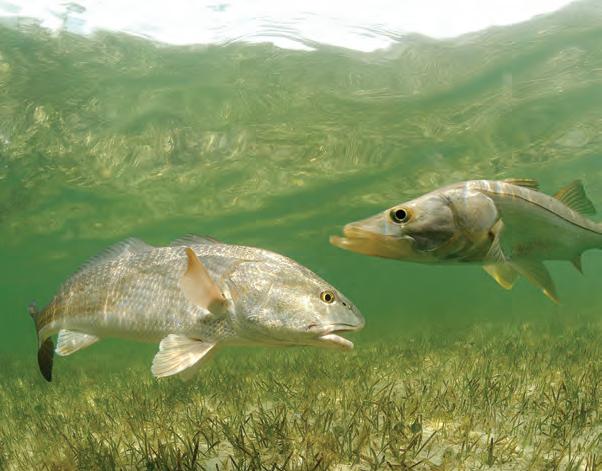


The International Game Fish Association (IGFA) has long been a global leader in promoting ethical angling practices, game %sh conservation, and angler education. One of its most accessible resources is the Intro to Fishing course, a structured educational program developed by the IGFA to provide a comprehensive introduction to recreational %shing in an online setting. $is engaging and interactive course is accessible to anyone with an internet connection and equips participants with basic skills, fostering a deep appreciation for the sport.
Targeted at youth, families, and beginner anglers, the course covers various aspects of %shing, including:
• The Fish: Understanding what a %sh is and how to identify various game %sh
• The Habitat: Learn where %sh live and di erent aquatic environments
• The Basics: Learning various %shing techniques from basic tackle to casting methods
• The Ethical Angler: Emphasizing responsible %shing practices, catch-and-release techniques, and habitat protection

43 acres (+or-) 1100 feet (+or-) on Suwannee River in Lafayette County at US 27, across river from Branford. Heavily wooded, perfect for residence, camp ground or hunting lodge. Elec. and well.
• The IGFA: Introducing students to the IGFA $e IGFA’s Intro to Fishing course launched in 2019 as a means to o er a comprehensive curriculum covering angling basics and safety, aquatic and marine biology, %sh identi%cation, environmental stewardship and more to audiences around the world. Packed with educational presentations, how-to videos, and interactive quizzes, the course allows anglers to follow along at their own pace. To date, nearly 1,200 students have completed the course, ranging from IGFA smallfry anglers aged up to 10 years old to experienced adult anglers. Most students are from North America, speci%cally from 43 states across the USA, but students from 35 di erent countries on six continents have completed it as well. While most students who have completed the course have caught a %sh before, nearly 15% of students have

43 acres (+or-) 1100 feet (+or-) on Suwannee River in Lafayette County at US 27, across river from Branford. Heavily wooded, perfect for residence, camp ground or hunting lodge. Elec. and well.



Cary A. Crutchfield
Registered Real Estate Broker GRI and CRS Designations

recorded that they have never caught a %sh before taking the course, but it has helped inspire these students to get outside and go %shing.
“Being new to %shing, it sparked my interest to start to %sh the most I can,” said Landon M., an IGFA Junior angler aged 11-16 years old from Hawaii, USA, who %nished the course in 2022.
Many schools from primary to college have utilized IGFA’s Intro to Fishing online resource as part of their course curriculum as well. Evan F., a college student from Kentucky, U.S. back in 2020 when he completed the course, recently had this to say in a post-student survey asking how the Intro to Fishing course has impacted their angling career since taking the course, “I took this class in correspondence with a freshwater %shing class in college. It has helped me have a better understanding and what to do when %shing and given me practices I still use to this day.”
For more information about the course and how to participate, visit igfa.org/learning-modules/.

































The 2025 CCA Florida STAR competition presented by Yamaha continues to be Florida’s the largest family-friendly saltwater %shing competition. Running Saturday of Memorial Day weekend through Labor Day it boasts prizes & scholarships over $500,000 for anglers of all ages and skill levels.
$is year they’ve added the new Drum Spots “Lots-A-Spots” Division presented by Gulf States Automation. Red%sh with the most spots will win a share of $25,000 in prizes.

STAR’s signature Tagged Red%sh Division presented by TH Marine o ers %ve winners the choice of a Carolina Ski , Sea Born, Spyder Boat or Micro Dra! Ski , all powered by Yamaha. Two youth winners would win Carolina Ski 16-foot tiller boats powered by Yamaha, trailer, Minn Kota trolling motor and Humminbird electronics.
Each Florida coastal counties will have on average 4 green tagged red%sh released in their waters for a total of 167 prize winning tagged red%sh. Citrus and Charlotte Counties are Destination Counties with 8 tagged red%sh in their coastal waters.
$e Tigress Tagged Dolphin Division o ers a $10,000 cash prize for the %rst tagged dolphin landed.
$e Custom Gheenoe Inshore Division presented by Minn Kota and the Engel Coolers O shore Division presented by AFTCO allows 3 catch entries per day of competition and pays out 12 places with $60,000 in prizes in each.
You don’t have to catch a %sh to win a boat! Register before May 24th for one ra&e entry in the Triple Header Boat Ra&e. A Dek Kat 27 Trilogy, Spyder FX19 Vapor and a Carolina Ski 16JLS all powered by Yamaha will be given away on September 4, 2025.
$e Native Watercra! Kayak Division, Realtree Fishing Youth Scholarship Division, Power Pole Conservation Division and Costa Kick Plastic Trash Division o er amazing prizes too! ALL salt water species can be entered and most winners are determined by random drawing. Pick up the STAR Identi%er a!er May 17 at any West Marine store or distribution location.
Registration is $80 which includes CCA Florida membership. Kids ages 6-17 can register for free with current ($10) CCA Florida youth membership.
For more information on STAR, or to register, visit cca star.com
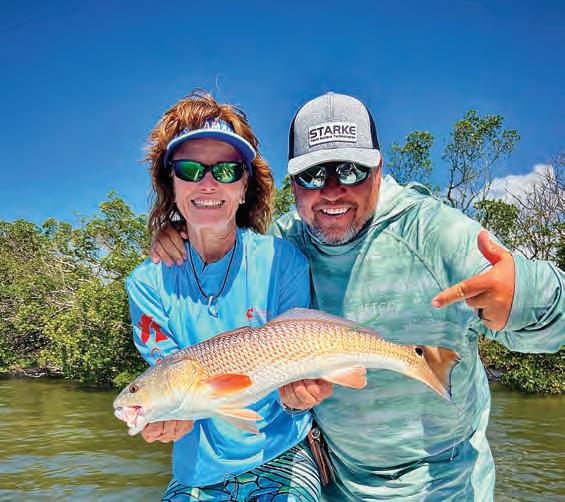
CTim Barefoot

an you say hallelujah? HALLELUJAH!!! $e powers that be say we can %nally catch and retain grouper as the season opens back up May 1. Decades ago, I never thought I would have said “grouper” and “season” in the same sentence, much less enduring this nine- or 10-months out of the year closure we’re experiencing now.
We recently took a recon trip to the edge to catch African pompano, but caught everything but African. $e barracudas and sharks are in numbers never seen before (by myself and a LOT of my friends), along with the American red snapper (ARS) and gag grouper. For anyone doubting the American red snapper and/or gag grouper numbers, please speak up now...or please come %shing with me!
We decided to leave the shark- and barracuda-infested deep water to catch some legal dinner %sh like grunts and seabass. We came inside a good ways and stopped on a pretty piece of bottom and it was nothing but gag, scamps and ARS bites. BAM! BAM! BAM!

Rolled back in another 10 miles knowing we were going to catch some seabass and grunts…and got nothing but gag and ARS bites. A!er that, we decided to go another eight miles inside speci%cally for sea bass, %nding traditional sea bass numbers. Fishing around in that general area, we ran out of all frozen cigar minnows and cut Spanish mackerel chunks before we could catch a good limit of sea bass.
I said all that to say this: %sh the pretty bottom marks of bait and structure using the correct tactics and you will have a heavy box of good %sh at the end of the day.
All the best %shing...
For more info, check out Tim Barefoot’s YouTube channel and website, barefootcatsandtackle.com.
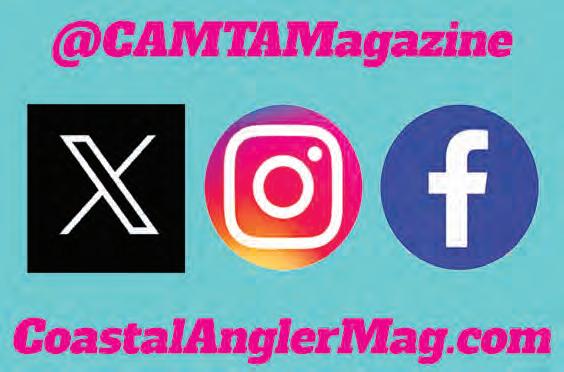








A!er breaking shermen’s hearts by releasing trophy grouper throughout the closed season, May is nally here, opening grouper season for anglers on the Atlantic Coast. I, for one, am thrilled to be able to add these tasty critters to the icebox yet again.
e red grouper is one of the most popular bottom sh found along the southeastern coast of the United States, particularly in the Gulf of Mexico and the Atlantic Ocean. It’s rm, white esh and rich avor make it a favorite for the majority of o%shore anglers. Easily recognizable by its reddish-brown coloration, the red grouper features scattered white blotches and a stocky body that suits its role as an ambush predator in rocky reef environments. Pulling one up from the depts that they exist in is the price you’ll pay to put this meat on your table because they’re also able to aggressively resist your will and challenge your strength. I like targeting them using live or cut bait. Once hooked, they tend to dive back into structure, which makes landing them a rewardingly brutal experience.
those who regularly bottom sh the overabundance seems to be more of a problem than the reduced stock assessments that NOAA has promoted.


e National Oceanic and Atmospheric Administration (NOAA), has attempted to monitor stock assessments of red grouper, although many cite awed data in their forecasts. e catch limits and season closures that they’ve implemented have substantially reduced the angling communities’ opportunities to catch this highly sought a!er sh. For

I could be wrong, but it seems as if NOAA has become antirecreation-fishing oriented. eir policies and choice of data has created a distrust among many (most all) anglers these days. While ASA and numerous other angler organization have attempted to impact NOAA’s trend toward “Don’t Catch,” much remains to be done to correct the adversarial relationship between the American angler and this once highly respected organization. My small home town once had an animal control o cer that hated and abused stray dogs. Once the community brought this to the attention of local government o ce the problem got solved relatively quickly. ey red him. No more problem. Has it come time to re the management team of NOAA?
Disclaimer: e views and opinions expressed in this column are those of the writer and do not necessarily re ect the views or positions of Coastal Angler Magazine or any entities they represent.















By Paul MacInnis
Catching channel cat sh can be a lot of fun and super rewarding—these guys ght hard! And the nice thing about cat shing is you don’t need fancy baits or tackle. If you want to target bullheads and smaller pan-sized cat sh you can use baits you gather right out of the river like grass shrimp and mussels. You can also use earth worms or small chunks of hotdog. Fish these baits on a 1/0 Aberdeen hook and add just enough split shot to your line to hold bottom.
But I prefer to target bigger channel cat sh, the bigger the better, using peeled shrimp for bait. You don’t need fresh shrimp, a bag of frozen shrimp from your local bait shop works ne. I also like to use cut bait as it holds up well to the bait stealers. Cut mullet or chunks from just about any sh work.
I use a standard sh nder rig. Run the line through a one-quarter to one ounce egg sinker, choosing just enough weight to hold bottom. Tie the line to a swivel and add about one to two feet of twenty pound test mono lament to the other end of the swivel. To the end of this leader I tie a 4/0 Team Cat sh TC84Z circle hook.
Baitcasting gear used for bass shing and 2000 to 3000 sized spinning tackle works ne for channel cats. You can get by with inexpensive mono lament, but I prefer a good quality 10-pound test braid like Platypus Platinum Plus. Braid won’t bow out as much as mono lament due to wind or current so it gives you a straighter connection between rod tip and bait. is kind of tackle can get sporty if a 10-pound-plus cat sh takes your bait, but sporty is exactly what I am looking for!






Popular wisdom says you should sh your baits in the deeper bends and holes. I shed that way for years and caught plenty of one to ve pound cat sh, but bigger sh eluded me. Many rivers (even lakes) are loaded with little coves and basins. I’ve learned if there is three feet or more of water in these basins there’s a decent chance there will be some nice cat sh there. I’ll park my kayak at the edge of the opening and cast a bait towards the center of the mouth of the cove, trying to place my bait in the slack water but close, within 10 feet or so, of the current. If I am feeling ambitious I’ll toss a second bait towards the back of the cove. Most of the time the biggest cat sh go for the bait close to the cove mouth...but that isn’t always the case. I like to let the circle hook do all the work so I’ll leave the rods in the rod holders until a sh puts a good bend in the rod and maybe even takes drag. Keep your ears open for loud splashes as channel cats will o!en thrash at the surface right a!er feeling the hook. Also watch your line. Cat sh don’t always take the bait going away from you. If your line goes slack or your bait changes position reel up tight and see if there is a sh on the line. Finally, if you start catching a lot of bow n you might want to move elsewhere (unless you like catching bow n) because I nd cat sh and bow n seldom share the same locations.
Channel cat sh can be aggressive predators and many a bass angler has been surprised when a big cat grabs their bass lure. Most of the time I wouldn’t advise tossing lures as an e cient way of targeting cat sh, but some years there is an exception that happens in spring into early summer. Winter and spring are typically dry season and water levels drop. Fish congregate in what deeper holes are le! and become aggressive due to high competition for food. is is one time when you can readily catch cat sh on lures and even ies. I like small plastic worms and other so! plastic baits bumped slowly along the bottom. Keep in mind cat sh are primarily scent feeders so dousing your lure with a decent sh scent helps.
During low water you’ll occasionally run across a real treat, a sandy bottom pool where you can spot cat sh and sight cast to them. I highly recommend a quality pair of polarized sunglasses with an amber tint and mirror coating to help you tell cat sh from gar and tilapia.
I suggest you give shing for channel cats a try, especially on those days when “game sh” don’t cooperate. Be patient, stay persistent, and enjoy the process!
When you rst drop your boat in the water, o!entimes it can be extremely overwhelming on where to sh and what to throw. One bait I have found in particular seems to catch bass at every lake I go to. is bait is a bladed jig, better known as a chatterbait. e bladed jig is a extremely versatile bait, meaning you can throw it around so many di%erent types of cover and sh it at many varying depths. It allows you to cover a vast amount of water and locate bass that would usually take days to nd with other baits.
As you approach a new lake or even one you have been to a thousand times, it’s always a good idea to throw a con dence bait that you know will get bites. e chatter-bait is mine. I’ve found that no matter the cover, grass, trees, docks, riprap, etc., it gets bit. With the blade on the front vibrating so erratically, it allows this bait to come through cover extremely well and creates a reaction strike no other bait can.

their home. Depending on the time of year and what kind of bait the bass are feeding on where you are shing, there is a color made to match the hatch. If shad is the prevalent forage, I like to stick to a white or a bait sh color like a pearl and silver with a silver colored blade. If it’s bluegill, you can get by with a green pumpkin or anything with some yellow and orange mixed in with a darker blade color. Sometimes water color can play a factor in color choice as well. If the water is very dirty, you will have to use a color that will stick out so that they can see it pass by. Something like a white and chartreuse with a white blade (for bait sh imitation) or even a bright orange with a black blade (for craw sh imitation) can do the trick.
TYLER WOOLCOTT

Buying a bladed jig and tying it directly on your rod usually isn’t too e%ective without putting a trailer on the back of it. I like to try and match the color of the trailer to the color of the skirt on your chatterbait of choice to get the most natural look for the sh. e type of trailer can be a bit more complicated. I use either a swimbait style trailer with a boot tail or a apping style trailer like a craw pattern. e boot tail stands out when sh are very aggressive and aren’t scared of the more aggressive action the boot tail causes behind the bait. e appy trailer is better for highly-pressured sh that want a little more of a subtle approach who might not like the amount of action a swimbait trailer has.
A chatterbait is a very dominant bait all across the country and I rely on this bait at all times of the year to help me put sh in the boat. Next time you hit the lake, give the chatter-baitt a try and cover some water!
Let’s talk about matching the chatterbait to the bait forage. By matching the color of the bladed jig to the forage in the lake, a bass can’t resist it as a nice snack when you reel it through
Sizes and weights of your bladed jig are extremely important. With sizes ranging from 1/4 oz. all the way to 1.25 oz., the depth you are shing will decide what you tie on. I typically start with a 3/8 oz. or a 1/2 oz. which will allow you to cover water depths from 1 to 10 feet depending on your retrieve. If I nd some deeper cover that i want to get down to and sh, I will go a little heavier to a 3/4 oz.

Whether you’re fishing in a kayak, canoe, or small boat, the ePropulsion eLite 500W redefines your on-water experience with innovative features and commitment to sustainability. Designed to be the most compact and lightweight electric outboard in its class, it is an easy-to-use alternative to small internal combustion engines for enthusiasts worldwide. Max 5.6 miles at half throttle and 3.5 miles at full throttle.
BLADED JIG GEAR: When throwing a bladed jig its important to have the correct gear. I use a 13 Fishing Myth Rod 7’5 MH-mod paired with a 13 Fishing Concept A 7:5:1 reel. I spool this up with 17 lb. Su x Advance Fluorocarbon line making this the perfect combo for the job.
Tyler Woolcott is a professional tournament angler and guide. Check out his website at www.tylerwoolcott shing.com.






— Gene H.

Switzerland is synonymous with expensive, big-name luxury watches like Rolex®, Piaget® and Patek Philippe® that sell for thousands, but the Stauer Swiss Tactical Watch delivers Swiss precision for a fraction of the cost. Inspired by military timepieces like the American A-11, it combines rugged performance, simplicity, and legendary craftsmanship — built for action, not display cases.
Precision Takes Time
Swiss excellence demands patience. Each Stauer Swiss Tactical takes nearly nine months to complete, and this is a limited edition of 4,900. Crafted by master watchmakers, some of whom have worked with the other prestigious brands, this is your chance to own a rare, precision-engineered tactical watch without the inflated luxury price tag.
Why Pay for a Name?
Big brands charge more for status. Stauer delivers the same quality and precision with high-contrast markers for instant readability, a shock-resistant case to withstand hard knocks and Swiss-made movement for impeccable timing.
Limited Offer – Act Now
Don’t miss this rare combination of Swiss craftsmanship and unbeatable value. Only 4,900 available — once they’re gone, they’re gone.
Why pay more when you can own precision, heritage, and adventure for less? Order now — time is running out.
Watch Speci cations:
• Made in Switzerland with precision Swiss Ronda 515 movement. Stainless steel caseback. Brown leather band
• 44 mm diameter case. Date window at 3 o’clock
• Water-resistant to 3 ATM. Fits wrists up to 8 ¼”
Stauer Swiss Tactical Watch
$399 $59* + S & P Save $340
*Special price only for
APort Arthur, TX angler and his friends recently achieved an extraordinary feat— reeling in an enormous 884-pound blue n tuna.
On April 10, David Esslinger and his friends were shing in the Gulf when the massive sh struck his line with incredible force. He had no idea he was about to embark on the most intense battle of his shing career. ankfully, Esslinger had an eager crew by his side, ready to assist in landing this remarkable sh.
“Let me break down the day and the events for you. First o%, for those who have never landed a sh the size of a car, this is no small feat. No one accomplishes this alone,” Esslinger posted on Facebook.
e group set out early Friday morning. By 9 a.m., a!er a couple of hours of shing, they started noticing signs of a school of tuna breaking the surface of the calm waters. Suddenly, the right rigger snapped down with a forceful bite, signaling the start of Esslinger’s showdown against his monstrous tuna.
Esslinger recalls, “Big tuna started breaking the surface and our team’s spirits began to li! at’s when it happened—the right rigger came down hard. e sh ran about ten seconds and spit the 12/0 mustad hook and the bait. As my heart sank,
I came up on the drag and gave her 10 cranks. As soon as I engaged the clicker again the giant sh piled on again. at’s when the rst 3/4 spool run at 35 pounds of drag started.”
Realizing what was at stake, his team quickly got into position for the ensuing battle, clearing lines and the deck.
“I had to crank it up to 45 pounds of drag on the Tiagra to slow her down. She responded with a rush to the surface. Carson was at the helm with Brad, TC, Je%, and Colby, coordinating everything e ciently from cockpit to helm. We managed to get the sh up to the surface in just over an hour,” stated Esslinger.
A!er an exhausting ve-hour battle of strength and endurance, Esslinger and his crew nally brought the massive blue n alongside the boat. With shaking body and inoperable hands, Esslinger made his way to the side of the boat and screamed with utter shock, “What a giant blue n! We did it!”
is impressive catch is seen as a trophy sh among anglers, celebrated for its enormous size and high-quality meat. And it was indeed enormous. Weighing in at 884 pounds, this blue n tuna has set a new state record for the largest tuna caught in Texas, surpassing the previous record of 876 pounds established by Troy Lancaster in 2021.




By CAM Sta














You want AI Routing! Let TZ MAPS with AI Routing make route planning a snap. Don’t take our word for it. Scan here to see for yourself how easy it is!